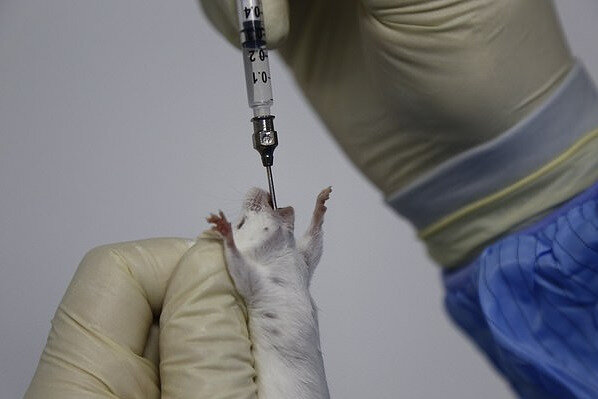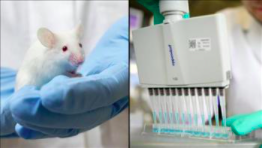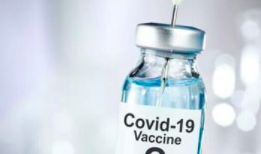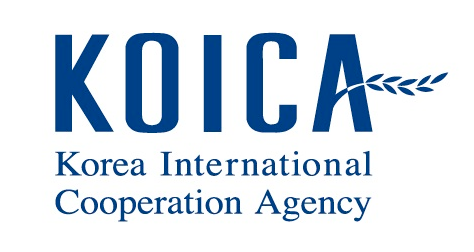Diabetes has long been considered an incurable disease. Patients can only manage their condition with medicines, insulin and especially a healthy lifestyle.
However, a new study published in the journal Nature Biotechnology is opening up the opportunity to completely cure diabetes, based on stem cell replacement therapy.
Scientists have injected human stem cells into animal models. The stem cells later turned into insulin-producing pancreatic cells - the cells that people with diabetes do not have or do not have enough function. As a result, the mice with severe diabetes recovered after 2 weeks of treatment and were healthy for 9 months later.
Basically, it could be said that they were cured.
 Scientists have a complete cure for diabetes in mice
Scientists have a complete cure for diabetes in mice
The new study was conducted by a team of scientists from Washington University, USA. In it, they found a way to turn human pluripotent stem cells (hPSCs) into beta cells in the pancreas.
Beta cells in the pancreas produce insulin, a hormone that pulls sugar out of the blood and provides the cells with energy. In diabetics, they either do not have enough beta cells, or the cells have lost their insulin production function.
The consequence of not having enough insulin so that sugar will build up in the blood, leading to dangerous complications such as damage to internal organs and especially heart disease. Many diabetic complications are dangerous and can lead to death.
Meanwhile, pluripotent stem cells (hPSCs) are basically "empty cells". These cells can develop into any cell in the human body. That means they can also turn into pancreatic beta cells.
With this in mind, researchers at the University of Washington spent years studying the development of pluripotent stem cells, figuring out how to "coax" them into the path to becoming pancreatic cells.
Since 2016, they've turned pluripotent stem cells into beta cells, with low insulin production. After a few years, the process continued to improve and the level of insulin produced increased gradually.

In this newly published study, they addressed another major challenge: reducing the number of "out of target" cells created during this process. That means more beta cells will be formed when growing stem cells.
"A common problem when you try to convert human stem cells into insulin-producing beta cells - or neurons or heart cells - is that you also [inadvertently] produce other cells that you don't want" explains Jeffrey R. Millman, a biomedical engineer in a research group at the University of Washington.
"In the case of beta cells, we can get either liver cells or other cells in the pancreas [not beta cells so we can't produce insulin]."
The researchers explain that these "off-target" cells are not harmful, but they have no effect on diabetes, so they will be a wasteful resource.
"The more cells outside the target you get, the fewer cells you will be able to treat," Millman said. "You need about 1 billion beta cells to treat diabetes. But if a quarter of the cells you make are not beta cells but liver cells or other pancreatic cells, instead of one cells, you'll need 1.25 billion. It makes it 25% harder to cure. "
To overcome the problem, Millman's team exploited a transcription process that encourages stem cells to turn into pancreatic cells. The transcription factors bind to a supporting structure inside the cells that act as a framework, made up of microfibre of various protein fibers.
One of these proteins, called actin, plays an important role in cell function and, it turns out, also affects cell differentiation, which can turn a pluripotent stem cell into a beta cell in the pancreas.
"We found that manipulating cellular biomarker interactions and the state of actin changed the time of expression of the endocrine transcription factor and the ability to differentiate pancreatic cells into beta cells derived from stem cells," the authors explain in their paper.
In other words, by controlling actin and stem cell status, Millman and his colleagues turned stem cells into beta cells at a greater rate. "We were able to create more beta cells and those cells performed better in mice," Millman said.
"The mice with very severe diabetes had a blood sugar index of more than 500 milligrams per dL of blood - a level that could be fatal for humans. But when we injected the mice with insulin-secreting cells, within two week, their blood sugar levels have returned to normal and remain that way for months. "
One of these mice even cured for more than a year. In comparison, all mice with diabetes but no other treatment were killed.

It must also be said that successful treatment of diabetes in rats is only a step toward the final result, where we can expect this method to work for humans as well. Scientists said that before going to clinical trials on real patients, they will still have to conduct studies on large animals.
This process may take a few years. However, the application of stem cell differentiation technology will not stop at diabetes treatment. The same method could be used to turn stem cells into other types of cells more efficiently, including liver cells, esophagus, stomach, and intestines, the scientists said.
Therefore, although it will take many years to perfect this technique, it will be an arrow hit many targets. Research by the University of Washington can contribute to improving all stem cell therapies, used to treat a variety of other conditions, not just diabetes.












